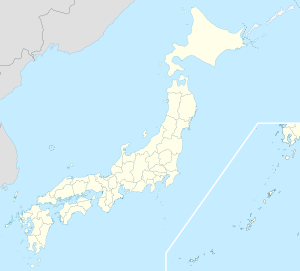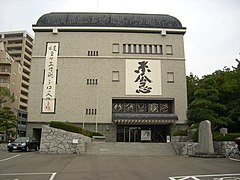Matsuyama
| Matsuyama-shi 松山 市 |
||
|---|---|---|
| Geographical location in Japan | ||
|
|
||
| Region : | Shikoku | |
| Prefecture : | Ehime | |
| Coordinates : | 33 ° 50 ' N , 132 ° 46' E | |
| Basic data | ||
| Surface: | 429.04 km² | |
| Residents : | 509.139 (October 1, 2019) |
|
| Population density : | 1187 inhabitants per km² | |
| Community key : | 38201-9 | |
| Symbols | ||
| Flag / coat of arms: | ||
| Flower : | camellia | |
| town hall | ||
| Address : |
Matsuyama City Hall 4 - 7 - 2 , Niban-chō Matsuyama -shi Ehime 790-8571 |
|
| Website URL: | http://www.city.matsuyama.ehime.jp | |
| Location of Matsuyamas in Ehime Prefecture | ||
Matsuyama ( Japanese 松山 市 , - shi , dt. "Pine Mountain") is the administrative center of the Ehime prefecture . The largest city on Shikoku Island is located in the west of the Takanawa Peninsula . She has had a university since 1923 .
history
The origin of the city lies in the village near the castle Matsuyama-jō , the center of feudal rule ( Han ) Iyo-Matsuyama . After the Meiji Restoration , the Han was dissolved in 1871 and the city of Matsuyama was founded in 1889. Little by little , the surrounding towns were incorporated, for example the Dōgo-Onsen thermal baths ( 道 後 温泉 ) in the east and the Mitsuhama harbor ( 三 津 浜 ) in the west.
After the German leased area Kiautschou surrendered to Japan in November 1914 , German prisoners of war were interned in Matsuyama from 1914 to 1917.
Attractions
Matsuyama-jō Castle was built at the beginning of the Edo period (1603) on the 132-meter-high Katsuyama Hill. In 1784 the castle tower (Tenshu) was destroyed by lightning, but from 1820 to 1854 it was restored in the original shape in which it has been preserved since then - despite some bomb damage in World War II. The complex with its spacious park is connected to the city by a cable car.
Of the 88 station stamps on the traditional Buddhist Shikoku pilgrimage route , eight, No. 46-53, are in Matsuyama: Jōruri-ji , Yasaka-ji , Sairin-ji , Jōdo-ji , Hanta-ji , Ishite-ji , Taisan-ji and Enmyō-ji . Also worth mentioning is the non-associated Taihō-ji ( 大 宝 寺 ). The most important Shinto shrine in the city is the Isaniwa Shrine, built in 1664 .
Matsuyama is also famous as the city of Masaoka Shiki (1867–1902), the founder of modern haiku poetry. In memory of him, a haiku symposium is held every year and an international prize ( 正 岡 子規 国際 俳 句 賞 , Masaoka Shiki Kokusai Haiku-shō ) is awarded. Competitions open to everyone attract 3,000 amateur poets each year with around 50,000 submissions. A list from the local university library lists over 200 places in the city that are particularly associated with haiku poetry or individual haikus.
Natsume Sōseki , who met Shiki in 1887 as a classmate in Tokyo, lived in Matsuyama for about a year in 1895/96. He processed this experience in his 1906 novel Botchan . The eponymous hero, a young math teacher who was sent to the provinces from Tokyo, like Natsume Sōseki himself, likes to visit the famous Dōgo Onsen in his spare time . It is considered to be the oldest thermal bath ( onsen ) in Japan, which Prince Shōtoku is said to have visited in 596.
Transport, business, sport
The local public transport is served by buses and trams of the company Iyo Tetsudō ( 伊 予 鉄 sowie ) and its three rapid transit lines Takahama , Yokogawara and Gunchū . Long-distance traffic is available on the Yosan Line from JR Shikoku to Takamatsu or Uwajima , the Matsuyama Highway ( 松山 自動 車道 ), National Roads 11 to Tokushima , 33 and 56 to Kōchi and Matsuyama Airport . The shipping company Setonaikai Kisen ( 松山 自動 車道 ) offers ferry connections with Hiroshima ten times a day by ferry (travel time 3 hours) and fourteen times a day by speedboat (travel time 75 minutes).
In addition to tourism, mechanical engineering , the paper, textile and chemical industries, an oil refinery and the port are of economic importance. Citrus fruits , among other things, are grown in the surrounding area .
Matsuyama is the home of the Ehime FC football club . The baseball team Ehime Mandarin Pirates ( 愛媛 マ ン ダ リ ン パ イ レ ー ツ ) from the Shikoku Island League Plus ( 四 国 ア イ ラ ン ド リ ー グ plus) plays in the Matsuyama Chūō Kōen , nickname 30,000 Plana ( 中央 公園 野 野 球場 ) Stadium . There and in the neighboring Madonna Stadium the games of the women's baseball world championship 2008 were played. West of the station Ichitsubo ( 市坪駅 ) of the Yosan-line and between the rivers Ishite-gawa and Shigenobu-gawa ( 重信川 ), the two baseball stadiums with the group Matsuyama Keirin - Velodrom , the floating ground and the Ehime-ken BUDOKAN -Hall around the "Matsuyama Central Park" ( Matsuyama Chūō Kōen ).
Neighboring cities and communities
Town twinning
-
 Freiburg im Breisgau , since 1988
Freiburg im Breisgau , since 1988
-
 Pyeongtaek
Pyeongtaek
-
 Sacramento
Sacramento
sons and daughters of the town
- Akiyama Yoshifuru (1859–1930), army general and brother of Akiyama Saneyuki
- Masaoka Shiki (1867–1902), poet, literary critic and essayist
- Akiyama Saneyuki (1868–1918), Navy staff officer
- Kawahigashi Hekigotō (1873–1937), haikuist, essayist
- Takahama Kyoshi (1874–1959), poet and writer
- Aibara Shirō (1880–1911), naval officer and aviation pioneer
- Mansaku Itami (1900–1946), screenwriter and director
- Tadao Tannaka (1908–1986), mathematician
- Yasuhisa Shiozaki (* 1950), politician
- Rieko Matsuura (* 1958), writer
- Mika Saiki (* 1971), volleyball and beach volleyball player
- Chiaki Kusuhara (* 1975), beach volleyball player
- Makoto Tamada (* 1976), motorcycle racer
- Reiko Tosa (* 1976), long-distance runner
- Kazuhito Watanabe (* 1986), football player
- Takanori Maeno (* 1988), soccer player
- Ryō Aono (* 1990), snowboarder
- Tsubasa Kubo (* 1993), football player
- Kanako Murata (* 1993), wrestler
- Yoshiki Fujimoto (* 1994), soccer player
- Yoshiki Matsushita (* 1994), soccer player
- Yutaka Soneda (* 1994), soccer player
- Shūma Mihara (* 2001), soccer player
Web links
- German city tourism website
- Haiku Monuments in Matsuyama (English)
- Isaniwa Shrine ( Memento of May 3, 2007 in the Internet Archive ) (English)
Individual evidence
- ↑ Hans-Joachim Schmidt: Overview of the Matsuyama camp. In: Tsingtao and Japan 1914–1920. Historical-biographical project. February 15, 2018, accessed on January 22, 2019 (German, Japanese).









